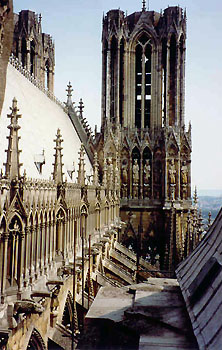HIS 101
Unit 12:
Late Middle Ages
Reims Cathedral (Notre Dame de Reims), Reims, France. This
is my photo from up on the rooftop of the cathedral in Reims,
France--Yes, the French let you climb on up to the roof to look around,
both under the roof on the inside and on the outside. What an
experience! Anyway, this cathedral, which dates to the thirteenth
century, was the coronation place for the French kings. The site
was considered sacred because legend has it that it was here that
Clovis, King of the Franks, was baptized by the bishop of Reims in 496 CE. That symbolized the Christianization of the Franks. During
World War I, the Germans thought that the cathedral towers were being
used as French observation points, and so the Germans shelled the cathedral,
destroying much of the facade's unbelievable sculptural work and portions of the upper
structure. Restoration work on the cathedral is an ongoing
project. |

|
 What you
must do in this unit
What you can do in this unit
What you
must do in this unit
What you can do in this unit
- Listen to some further information about this unit
as a mp3 file. You can also read the information as
a txt file.
- Carrie Griffith (fall 2017) created this story map on The Crusades.
Some videos that you can watch for this unit
- Crusades (sometimes you can find this online; try the Khan Academy lectures)
- The Crusades - Pilgrimage or Holy War?: Crash Course World
- History Channel - The Plague (sometimes you can find this online, maybe here)
- History's Turning Points - AD 1347 The Black Death (sometimes you can find this online)
- Chartres Cathedral
- Cathedral is a great documentary done by David Macauley. It explains all the different aspects of the building of a medieval cathedral. Watch it, if you can find it somewhere.
- For extra credit please suggest to your instructor a relevant video for this unit of the course. Send the title of the video, the URL and a brief explanation of why you find the video interesting and applicable to the material that is being studied in this unit.
Extra Credit Options
- For up to 50 points of extra credit, read Chaucer, Canterbury Tales (only those tales in the Dover Thrift paperback
edition: the General
Prologue, Knight's Tale, Miller's Prologue, Miller's Tale, Wife
of Bath's Prologue and the Tale of the Wife of Bath) and submit the Chaucer paper.
- For up to 25 points of extra credit, read
Cantar 1 of the Cid poem and write a one-page paper in
which you comment on Christian-Muslim relations in the Cid poem. The Robert Southey translation from 1637 is also available.
- For up to 25 points of extra credit, read Dante's Inferno and comment upon his use of allegory and the medieval conception of
the universe. Please be sure to cite any sources that you use.
- For up to 25 points of extra credit, watch the movie Monty Python and the Holy Grail. Considering that the movie is a satirical comedy,
write a one-, or two-page paper concerning the aspects of life in the Middle Ages that were well
portrayed in the film. There is no better movie that examines some of the bizarre features of life in the Middle Ages.
- For up to 25 points of extra credit, in
a one-page paper, summarize the causes and outcomes of the Hundred
Years' War. Please be
sure to cite any sources that you use.
- For up to 25 points of extra credit, if you are really daring, read the full text of the Transcript of the Trial of Joan of Arc, and write a short paper in which you assess what was really going on at the trial.
- For up to 5 points of extra credit, answer the Chaucer study sheet questions.
- For extra credit, please suggest a
relevant website for this unit of the course. Send your instructor the title of the site, the URL and a brief explanation why you find the information interesting and applicable to the material being studied this unit.
Unit Learning Objectives
- Upon successful completion of this unit, you will be able to (1) identify some of the achievements of medieval culture, (2) assess the impact of the Black Plague on medieval society and (3) note some of the lasting institutions of the Middle Ages, such as the university.
|



